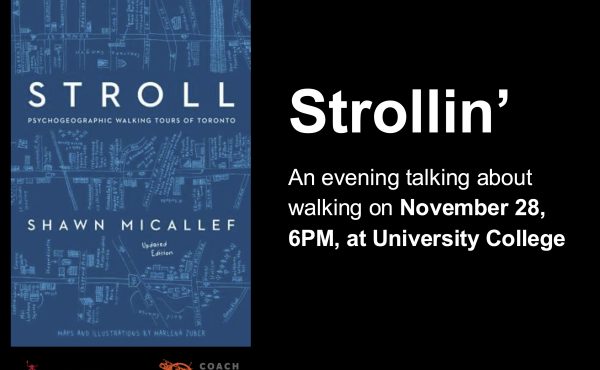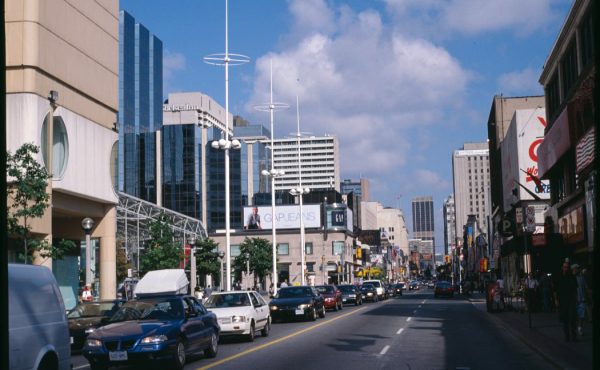Last week, I went to have a look at how the new pedestrian space pilot project in the University of Toronto is coming along. A block of Willcocks Street, between St. George and Huron, has been closed to traffic and turned into a public square. The project uses the model of New York’s closing of Times Square, using inexpensive, temporary materials to see the impact of the project before any significant, permanent changes are made. As part of the same initiative, Ryerson University has made a section of Gould Street into a pedestrian space as well.
Both universities partnered enthusiastically with the City to implement these projects, agreeing to maintain the spaces if the City provided the start-up costs. The City bought planters and chairs and tables to close off the streets and animate the space, but also provided all small budget to each university to come up with their own ideas for transforming the space. The University of Toronto got architecture students to design a stencil for the pavement — a big blue oak leaf that reflects the University’s logo. It also got the brilliant idea to buy some astroturf and lay it down in sections of the street, which really helps to define and soften the space. On the Huron end of the block, it added basketball hoops. And, of course, the whole area is provided with free Wi-Fi.
The astroturf will be rolled up when winter comes around. Originally, the University wanted to put in an ice rink, but it turns out that there are buildings and utilities under the road that keep it too warm. An alternative might be to use one of the recently developed synthetic ice surfaces (I saw one in action this summer, with kids successfully using their ice skates on it).
The Willcocks experiment has been very successful — it is well located, at a crossroads of many routes across campus, right beside heavily used classroom buildings and a student food court, and near residences and the athletic centre. U of T has a very large population of non-resident students and a lack of space for them to spend time in while on campus, so it satisfies a definite need.
The tables and chairs have not been damaged or stolen (the tables are all provided with a chain with which they are locked to the chairs every night) — the only problem has been people pushing over the planters at night.
The advantage of using this pilot project model can be seen in the case of Devonshire Place (above). The University of Toronto was keen to also close down this stretch of road, which is not heavily used by cars. However, the newly pedestrian space did not end up being as heavily used as Willcocks — it is a little more out of the way. Thanks to the inexpensive, flexible implementation, it was easy to adjust to this outcome. The City left it up during the nicer part of the Fall, but decided to close the project for the winter. On Friday (Oct. 18), the City removed the planters and chairs (which can be re-used elsewhere), and the street was once again open to traffic. The partners plan to re-think the project in this part of campus over the winter and try something different in the spring. One possibility might be to use part of the street parking space for other purposes — for one thing, bike parking is very much needed in the area (as can be seen by the number of bikes locked to the Munk Centre fence).
The Willcocks Street closure is slated to last a full year. The City plans to hire an independent organization to assess its success over the year, and if it proves to be successful, there will be an opportunity to make the installation more permanent (as happened with Times Square).








11 comments
Overall I think the pilot project on Willcocks is great. I hope it becomes permanent and inspires further pedestrianization in the city. But one small quibble: the traffic lights at Willcocks and St George are still up and running as if Willcocks were open to traffic, which means motorists (and, in theory, cyclists) have to sit and wait for no good reason. The lights should be covered over and replaced with a stop sign for the duration of the pilot project. Lots of pedestrians are already ignoring the lights anyway, and just crossing whenever there’s a gap in traffic.
Times Square is surrounded by commercial stores and restaurants on the first level. Can Willcocks say the same? Would be nice if there were green grocers, delicatessens, and small shops, not just empty space.
The pilot projects at U of T really miss the point of the New York projects. To me this looks like someone liked the idea but either didn’t understand the point of it or didn’t have the guts to actually do this where it would impact car traffic. In New York, the idea there was to find areas that did not have adequate levels of public space and fix that by closing or narrowing streets without regard for car traffic. The U of T locations seem to have been picked because they had minimal impact on traffic, not because they serve a need that’s currently unmet. It would actually make sense to do this where this is currently nowhere to sit!
W. K., this is right in the middle of U of T. It’s not exactly prime territory for green grocers, or anyone else not selling fritos, doughnuts, or burgers.
What happened to the pedestrianization of the south end of Devonshire? The road seems to have been closed for a month or so, but recently the planters seems to have been removed and the road reopened to cars. Did the city council pull the plug on the closure of that section of Devonshire?
Lis,
Willcocks is surrounded by classrooms, can Time Square say the same? It is not an empty space, it is full of pedestrians year-around. Sure it would be nice if there were more amenities, but the level of pedestrian activity can already justify the conversion.
I find this whole experiment very annoying. It blocks my regular cycling route to work.
I initially thought it was a temporary thing as part of the new university year. But it has stayed up. I actually called the city today to complain about it. They could have at least put up a sign explaining its purpose.
@ Steve, cyclists fighting pedestrian space? Toronto is too full of b’chy people to change.
I’m frustrated by this as a U of T student who cycles around the campus. Why can’t cyclists keep using Willcocks? It’s an important connection from the spine of the campus that is St. George Street to New College and other parts of the western campus like the Earth Sciences complex. Pedestrians get the street and sidewalks. The idea seems to be a “vehicle free” space and the tables were (at least at first) strategically placed so cyclists would be excluded too.
They should reconstruct the street to have segregated bike lanes if “absolutely vehicle free” is such a wonderful ideal. There are many options for accommodating cyclists. I don’t see why a space for pedestrians has to exclude cyclists.
As I understand it, pedestrian + bicycle only streets are illegal under the Ontario highway traffic act. Pedestrian only streets are allowed, but as soon as one class of vehicles is permitted (bicyles), all classes of vehicles MUST be permitted (cars & trucks).
Yet another side effect of the strange legal status of bikes. There’s no reason people on foot and bikes can’t mix safely like they do on the rest of campus every day.
The comparison to Times Square lies in the process, not in the context – using a flexible pilot project approach first to see how a pedestrianization project turns out. It can be applied to many different kinds of pedestrian projects, whether a huge intersection or a campus street or some other context. The key is to do a project somewhere where the space is used by people – which Willcocks is.
It’s also worth pointing out that the Times Square project was sold, in part, as a way of improving car circulation, not reducing it (by simplifying the New York grid).
Andrew > the final part of my post is about what happened on Devonshire.